Are you wondering how to seamlessly connect your AI chatbot with your current digital setup? Let’s explore effective AI chatbot integration strategies that can revolutionise your small business!
Table of Contents
Introduction
Integrating an AI chatbot with your existing digital tools can be a game-changer for small businesses. Not only can it enhance customer service, but it can also streamline operations and boost efficiency. But how exactly do you go about implementing effective AI chatbot integration strategies?
In this guide, we’ll explore the benefits of using chatbots and the best strategies for integrating them with your current systems. So, grab a cuppa, and let’s get started!
Understanding AI Chatbots
Evolution of Chatbots
Chatbots have come a long way since their inception in the 1960s, with ELIZA, the first chatbot created by Joseph Weizenbaum at MIT. While ELIZA could mimic conversation through pattern matching, today’s AI chatbots are far more sophisticated, thanks to advancements in Artificial Intelligence (AI), Natural Language Processing (NLP), and Machine Learning (ML).
AI Chatbots vs. Traditional Chatbots
So, what’s the difference between AI chatbots and traditional chatbots?
- Traditional Chatbots: Are rule-based and can only respond to specific, pre-defined inputs. Think of them as following a script.
- AI Chatbots: Powered by AI and machine learning, they can understand natural language, recognise patterns, and learn from interactions to provide more personalised responses.
Implementing effective AI chatbot integration strategies for small businesses can significantly enhance customer engagement and satisfaction.
Pre-Integration Considerations
Before diving into AI chatbot integration strategies, laying the groundwork is essential.
Defining Business Objectives
First, clarify what you want to achieve with your chatbot integration:
- Improve Customer Service: Faster response times, 24/7 availability.
- Automate Repetitive Tasks: Free up staff time for more critical tasks.
- Increase Sales: Provide instant product recommendations and support.
Ask yourself:
- What is the purpose of the chatbot?
- Who is the target audience?
- What specific tasks will the chatbot perform?
- How will it integrate with existing digital tools?
Assessment of Current Digital Tools
Next, take stock of your current digital landscape:
- What tools are you currently using?
- CRM systems like Salesforce or HubSpot?
- Email marketing platforms like MailChimp or Constant Contact?
- E-commerce platforms like Shopify or WooCommerce?
- Are there any limitations or compatibility issues?
Understanding your existing tools will help you plan effective AI chatbot integration strategies.
AI Chatbot Integration Strategies
Let’s explore practical strategies for integrating your AI chatbot with existing digital tools.
Strategy 1: API Utilisation
An Application Programming Interface (API) allows different software applications to communicate with each other. Utilising APIs is one of the most effective AI chatbot integration strategies.
- Example: Integrate your chatbot with your CRM system so that customer interactions are automatically logged and accessible to your sales team.
- Steps:
- Identify compatible APIs for your chatbot platform.
- Ensure APIs are secure and reliable.
- Work with a developer to integrate the chatbot using these APIs.
Strategy 2: Workflow Automation
Workflow automation tools can streamline repetitive tasks by connecting your chatbot to other digital tools.
- Example: Use Zapier or Microsoft Power Automate to connect your chatbot with your email marketing platform, so when a customer interacts with the chatbot, they are automatically added to your mailing list.
- Steps:
- Identify tasks that can be automated.
- Ensure your chatbot platform supports integration with automation tools.
- Set up automated workflows to connect your chatbot with other tools.
Strategy 3: Direct Integration with Platforms
Some chatbot platforms offer direct integration options with popular digital tools.
- Example: If you’re using Shopify, some chatbot platforms offer plugins or apps that can be directly integrated, simplifying the process.
- Steps:
- Check if your chatbot platform provides direct integration with your existing tools.
- Follow the provided guidelines for integration.
Strategy 4: Middleware Solutions
Middleware acts as a bridge between your chatbot and other applications.
- Example: Use middleware like Mulesoft or Dell Boomi to facilitate data exchange between your chatbot and legacy systems.
- Steps:
- Determine if middleware is necessary based on your systems.
- Select a middleware solution compatible with your tools.
- Configure the middleware to enable communication between your chatbot and other applications.
Best Practices for AI Chatbot Integration
Follow these best practices to make the most of your AI chatbot integration strategies.
User Experience Enhancement
Your chatbot should enhance the user experience, not hinder it.
- Natural Language Processing (NLP): Ensure your chatbot can understand and respond conversationally.
- User-Friendly Interface: Design an intuitive interface that’s easy to navigate.
- Visual Aids: Incorporate images, videos, or infographics to enrich interactions.
- Appropriate Tone: Use a tone that resonates with your target audience.
Continuous Learning and Adaptation
An AI chatbot should continually improve over time.
- Machine Learning Algorithms: Enable your chatbot to learn from user interactions.
- Regular Updates: Keep your chatbot’s knowledge base current.
- Performance Monitoring: Track how well your chatbot is meeting objectives.
- Feedback Mechanism: Allow users to report issues or suggest improvements.
Data Security and Compliance
Protecting customer data is paramount.
- Compliance: Ensure all integrations comply with regulations like GDPR.
- Encryption: Use secure APIs to encrypt sensitive data.
- Access Controls: Limit access to sensitive information within your organisation.
UK Case Studies: Successful AI Chatbot Integration Strategies
Case Study 1: “TechFix” Electronics Repair Shop
TechFix, a small electronics repair shop in Birmingham, implemented effective AI chatbot integration strategies by connecting their chatbot with their website and CRM system.
- Challenge: High volume of repetitive customer enquiries about repair status and pricing.
- Strategy Used: API Utilisation to integrate the chatbot with their CRM system.
- Result: Reduced response times by 60% and improved customer satisfaction.
Case Study 2: “Bloom & Blossom” Florist
Bloom & Blossom, a local florist in Manchester, used workflow automation as part of its AI chatbot integration strategy to connect its chatbot with its online ordering system.
- Challenge: Managing orders during peak seasons like Valentine’s Day.
- Strategy Used: Workflow Automation to link the chatbot with their e-commerce platform.
- Result: Increased online orders by 40% and reduced cart abandonment.
Common Challenges and Solutions
Challenge: Ensuring Seamless Integration
Solution: Work with experienced developers who understand your chatbot platform and existing tools. Test thoroughly before going live.
Challenge: Data Security Concerns
Solution: Ensure that all integrations comply with data protection regulations like GDPR. Use secure APIs and encrypt sensitive data.
Challenge: Chatbot Understanding and Accuracy
Solution: Implement robust NLP and continuously train your chatbot using real user interactions.
AI Prompts to Assist You
- ChatGPT, explain how to integrate an AI chatbot with a CRM system using effective strategies.
- ChatGPT, provide a checklist for ensuring seamless integration of an AI chatbot with email marketing tools.
- ChatGPT, describe potential data flow between an AI chatbot and a website analytics tool.
- ChatGPT, discuss best practices for maintaining data security when implementing AI chatbot integration strategies.
- ChatGPT, illustrate the impact of AI chatbot integration on customer data management.
Conclusion
Implementing effective AI chatbot integration strategies can transform your small business operations, enhance customer satisfaction, and give you a competitive edge. By carefully planning your integration approach and following best practices, you can unlock the full potential of AI chatbots.
So, why not take the plunge? Your customers—and your bottom line—will thank you!
Join the Conversation!
If you have any questions or need assistance integrating AI chatbots with your existing digital tools, please get in touch with us. We’re here to help you navigate this exciting journey!
Closing Thoughts
Embracing AI chatbot integration is a significant step towards modernising your small business. By seamlessly connecting your chatbot with your current systems, you’re setting the stage for enhanced efficiency and customer satisfaction.
So, grab that cuppa, and let’s get integrating!
Ready to revolutionise your business with AI chatbots? Subscribe to Clicks, our monthly online marketing guide for small businesses. Each issue is packed with practical tips, industry insights, and strategies to help you navigate the digital marketing landscape effectively.
Don’t miss out on our upcoming blog posts and the wealth of information in Clicks. Subscribe now and stay ahead in the ever-evolving world of online marketing.








